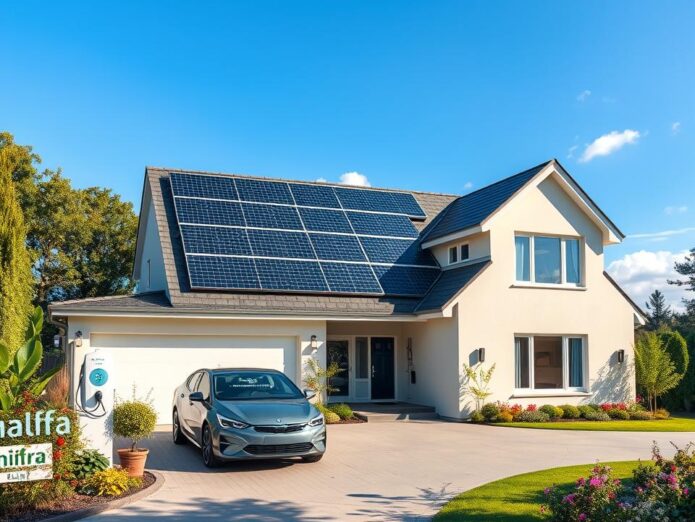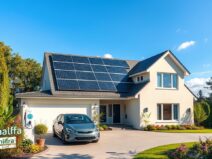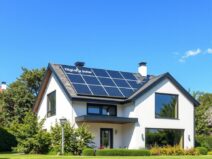On-grid solar is changing the game for homeowners in India. It uses the sun's clean energy to power your home and connects to the local electricity grid. This method cuts down on carbon emissions and brings many financial and practical perks.
Key Takeaways
- On-grid solar systems let you use solar energy and stay connected to the local power grid.
- These systems have many benefits, like lower electricity bills, more energy independence, and a positive effect on the environment.
- An on-grid solar setup includes solar panels, inverters, and net metering to connect with the grid.
- It's important to size your on-grid solar system right to get the most benefits and savings.
- Choosing on-grid solar is a wise move that offers long-term savings and helps the environment.
Understanding On-Grid Solar Systems
An on-grid solar system, also known as a grid-tied or grid-connected system, connects directly to the main electricity grid. This setup lets homeowners make their own solar energy. They can also send any extra power back to the grid, which lowers their electricity cost savings.
What is an On-Grid Solar System?
This type of solar system works with the traditional power grid. It uses the sun's energy for a reliable and green power source. The solar power can power your home. Any extra energy goes back to the grid, possibly earning credits through net metering programs.
Benefits of Going On-Grid
Switching to an on-grid solar system has many benefits for homeowners:
- Lower electricity costs from net metering and solar energy
- Less carbon footprint and support for renewable energy
- Eligibility for government incentives and tax credits, boosting financial gains
- Smooth integration with the current power grid, ensuring a steady energy supply
By using an on-grid solar system, homeowners can move towards energy independence. They also help make the future more sustainable.

Solar Panels: The Heart of Your System
Solar panels, also known as photovoltaic (PV) modules, are key to an on-grid solar system. They turn sunlight into electrical power for your home. Choosing and placing these panels is vital for your system's efficiency and performance.
Types of Solar Panels
There are many solar panels out there, each with its own benefits. Here are the main types:
- Monocrystalline solar panels - These panels are very efficient and look sleek. They're a top pick for homes.
- Polycrystalline solar panels - These are more budget-friendly. They're not as efficient but still give your home renewable energy.
- Thin-film solar panels - These are light and flexible. They're perfect for places with limited space or odd roof shapes.
Maximizing Solar Panel Efficiency
How well solar panels work affects your system's energy efficiency. Things like how the panels face the sun, their tilt, and shadows can change their performance. Keeping them clean and checking for damage helps them work better.
Picking the right photovoltaic panels and setting them up right makes sure your system gives you steady, affordable renewable energy at home.

The on-grid solar Inverter: Converting Solar Energy
The solar inverter is key to an on-grid solar system. It changes the direct current (DC) from solar panels into alternating current (AC). This AC power can power your home and send extra energy back to the grid. This process is vital for using your solar system with the wider power network.
Types of Grid-Tied Inverters
There are many types of grid-tied inverters out there, each with special features. Here are some common ones:
- String Inverters - These work with a group of solar panels, turning all the DC power into AC.
- Micro-Inverters - These small inverters are on each solar panel. They help optimize power and monitor it closely.
- Power Optimizers - These devices work with a central string inverter. They make sure each panel works at its best, improving the system's efficiency.
Inverter Efficiency and Performance
The efficiency and performance of your on-grid solar inverter are key to your system's success. Top-quality inverters can convert over 95% of solar energy into usable AC power. They also have features like maximum power point tracking (MPPT) and monitoring. These improve the system's performance and give you insights into how it works.
| Inverter Type | Typical Efficiency Range | Advantages | Disadvantages |
|---|---|---|---|
| String Inverter | 95% - 98% |
|
|
| Micro-Inverter | 95% - 97% |
|
|
| Power Optimizer | 98% - 99.5% |
|
|
When picking an on-grid solar inverter, think about its efficiency, performance, and how it fits with your solar panels and energy needs. This ensures the best energy conversion and value for your money.
Net Metering: Maximizing Your Solar Savings
Net metering changes the game for homeowners with solar systems. It lets you sell extra solar energy back to the grid. This way, you can lower your electricity bills. By knowing how net metering works, you can save more money and choose solar power as a green option.
How Net Metering Works
Net metering is easy to understand. When your solar panels make more energy than you use, the extra goes back to the grid. Your utility company gives you credits for this energy at the same rate they charge for electricity.
This means you can use the energy you sell back to lower your bills. It's a big way to save money each month.
Net metering rules change by state and utility, so check yours out. Look at the biggest system size allowed, the credit rate, and any extra fees.
Using net metering with your solar system can really pay off. It helps you get the most from your solar panels. This means you use less traditional power and pay less for energy.
| Net Metering Policy | Utility Rate | Annual Savings |
|---|---|---|
| Full Retail Net Metering | $0.12 per kWh | $1,200 |
| Partial Net Metering | $0.08 per kWh | $800 |
| No Net Metering | $0.05 per kWh | $500 |
The table shows how different net metering policies affect savings. Knowing your local rules helps you see the benefits of solar power.
Sizing Your On-Grid Solar System
Finding the right size for your on-grid solar system is key to meeting your energy needs and saving money. You need to look at how much energy your home uses and figure out the solar panel capacity needed. This ensures your system works well and helps you save more.
Assessing Your Energy Needs
Start by checking how much energy your home uses. Look at your past electricity bills to find out your average monthly and yearly energy use. This will tell you how big your solar system should be to cover your energy use and maybe even send extra power back to the grid.
Think about how many people live in your home, the appliances and devices you use, and any big energy-using upgrades you might plan for in the future. By knowing your energy needs well, you can make sure your solar system fits you perfectly. This way, you get the most financial benefits and help with sustainable energy.
FAQ
What is an on-grid solar system?
An on-grid solar system connects directly to the main electricity grid. It lets homeowners make their own solar power. They can also send extra energy back to the grid. This helps lower their electricity bills through net metering.
What are the benefits of going on-grid with solar?
Going on-grid with solar means lower energy costs and a smaller carbon footprint. It also lets you use government incentives for renewable energy. Plus, the grid acts as a reliable backup when the sun isn't shining.
What components make up an on-grid solar system?
An on-grid solar system has solar panels, a grid-tied inverter, and grid connection equipment. Solar panels turn sunlight into electrical energy. The inverter changes the direct current (DC) from panels to alternating current (AC) for your home and the grid.
How does net metering work with an on-grid solar system?
Net metering lets homeowners sell back any extra solar energy to the grid. This can lower their electricity bills a lot. The grid stores this extra energy and gives the homeowner credits.
How do I determine the right size for my on-grid solar system?
To find the right size for your solar system, look at your energy use and your roof's size and sunlight. A solar expert can help you figure out what you need based on these factors.





